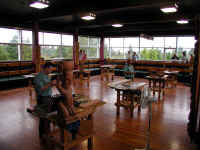 |
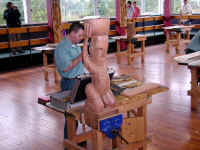 |
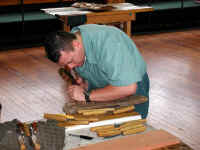 |
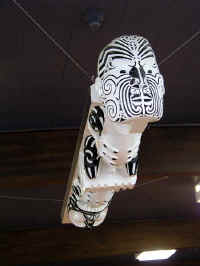 |
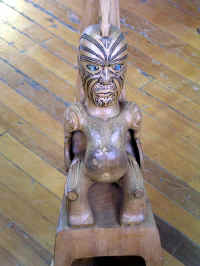 |
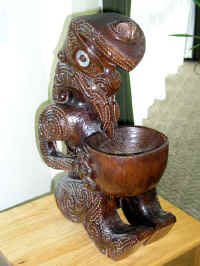 |
Carving is a central activity for the Maori. They use it to record
tribal history, genealogy, traditions, etc. One of the central features of the
institute is a school where they teach traditional Maori carving. The
students must meet certain requirements for admission (must be of Maori decent,
must be under a certain age, etc.). Only three students are accepted each
year. The coarse of study is three years long. "Like the
pictures of a book, carving is an expert's interpretation supporting an
otherwise solely oral history".
This is a recreation of a Maori village designed to show some aspects of a typical
living compound. Through the entrance on the left you can see the
meeting house where tribal gatherings were held. On the right is a typical
home with a small raised food storage building.
Pataka (Storehouse) This was used to store food as well as treasured items of
the villagers. The ornate storehouse was built and displayed for an
International exhibition at Christchurch in 1906. These storehouses were
more commonly found in coastal areas.
Wharenui (fa-ren-ui, Big House) The focal point for cultural interaction is Te Aronui -
a - Rua, their fully carved Meeting House. Trainee and graduate carvers of
the institute commenced construction in 1967 and completed the project in
1981. The opportunity to participate in the building of any tribal meeting
house is considered to be the pinnacle of a carvers career.
Here our guide is showing us how the flax leaves were processed in
preparation for making rope, clothes, baskets, etc. He demonstrated how
the fibers (like those found in celery only stronger) could be completely
removed to make rope, etc. or exposed in sections and stained to form a design.
This is a typical design created from the flax leaves. On the right you
can see the effect of exposing the fibers and staining them (black in this
case). The sections where the fibers are not exposed curls into a tight
tube as it dries.
Examples of clothing, etc. all made from flax, feathers, etc.:
Rotorua is known for its large amount of geo-thermal activity. In the 1900's, most houses and businesses had a 'bore hole' in the ground near their building. From this bore they drew steam and hot water that they used to heat the building, heat hot water, etc. It was a common sight to see a steam vent above each home venting the used/excess steam.
This practice was recently brought to an end because they discovered that all the steam and water lost through these bores was reducing the thermal activity in the geyser and mud pool areas which draw thousands of tourists each year. Because of this, the local government forced people to cap their steam bores. You might wonder how the government would know that someone had not capped their well - the flow of steam from the roof vent is a dead giveaway :-)
People come to the area for mud baths because it is believed that the mud from the pools has health benefits.
The geyser shown in the second to last photo below is the Pohutu Geyser which erupts once or twice an hour, reaching up to 30 meters in height.
This is another vehicle that Dave's company has built. These trams are used to transport people around to view the thermals. They are totally electric. The batteries are charged at several of the stops along the route when the vehicle pauses over one of the islands shown to load/unload passengers. The island contains a coil of wire that forms half of a transformer. The other half is on the underside of the vehicle. The power transfer is efficient enough that the vehicle is kept fully charged along it's route.
We were unable to ride the trams because one of the bridges had been
destroyed by thermal activity and was still in the process of being rebuilt.
New Zealand is known for it's 'Green Stone', also known as Nephrite Jade which is different from the Jade we normally think of which comes mostly from China. Nephrite Jade is only found in New Zealand, Alaska, Canada and Siberia. Diamond saws are used to cut the Jade from boulders it is embedded in.
On the way home from the Art Institute we stopped by a small Jade Factory (web site) where master carvers were producing traditional and contemporary designs. The traditional Maori designs represent strength, friendship, growth and harmony.
Of course, Joan had to purchase a memento before leaving the factory store ... :-)
The Rotorua Society of Model Engineer's track is located on the grounds of the Te Amorangi Museum Society. Among other things located on the grounds are, the Rotorua Society's 7.25"/5" gauge railway, a steam museum, and a house full of interesting antiques.
The railroad is small but has a lot of interesting features. They made
us feel welcome and right at home.
As with many of the tracks, it's hard to get a shot of the whole layout which makes sense but here are some shots of the steaming bay area:
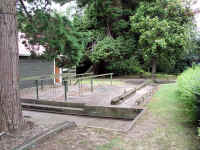 |
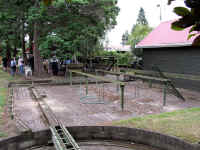 |
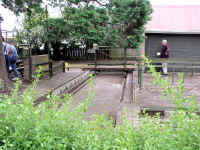 |
We had tea accompanied by scones, cream and jam, sandwiches, etc. A
great spread which could well have served as lunch - no one went away hungry :-)
On our way over to the machinery exhibits Larry and I saw this unusual Barrier Wind
Charger.
The precursor to the chainsaw, but definitely too heavy to haul up a tree!
The one on the right has a gas engine. The one on the left has a
cylinder but I didn't notice if it was steam, water or air driven.
I have never seen these before - three different types of old style clamps
for laying tongue and groove flooring
The boiler used to power the many operating engines shown below.
Some of the many engines in the steam building. Many, if not all, of them were in operating condition and connected to the steam supply.
"Heaps" Carriage Engine. The sign read: "We understand
that this engine was installed in 1954 at a mill near Tokoroa operated by Hutt
Timber and Hardware Co. Ltd. It drove the log carriage, which was on the
floor above, through an endless rope driven by the grooved drum. This twin
cylinder steam engine had no throttle valve and reversing was by a valve which
changed the direction of the steam flow. It operated until December 2000."
The Society has preserved this nice looking generator set, complete with the
control/distribution panel. Unfortunately it is not connected to steam
but, for display purposes, is turned over by an electric motor.
A Wier boiler feed pump. We have seen similar pumps in many locations
in New Zealand.
A well equipped shop for working on their engines, complete with lineshaft
driven machinery.
This was an unusual water pump (at least to Larry and I) as it had what
looked like some kind of counter balance mechanism on the right-hand side.
We couldn't figure out how the counterweight worked until someone told us that
it operated in a vertical position (i.e.: it's shown on it's back). It
then became clear that weights were placed on the disk at the right
to aid in lifting the water.
Here is a set of three different 'Water Rams'. These devices use the
force of water flowing down a hill in a pipe to pump a smaller quantity of water
to a height higher than the source of the water. It is a simple device, totally
self contained with just a couple of moving parts.
On the grounds was a small pioneer farm home built in the Dutch Colonial style.
The house contains 100's of interesting antiques and many artifacts associated with New Zealand's pioneer days.
This is the dining room with it's large table set for an elaborate dinner.
This was a sandblasted window in the dining room depicting a Maori boat on
its way
to meet a visiting ship.
This is a "Heliograph" used to signal across large distances by
reflecting the sun towards a distant hilltop, etc.
St. Faith's church is noteworthy because the chapel is decorated with Maori
carvings and one of the windows which has a sandblasted depiction of Christ walking in
Maori dress. If you are seated in the proper pew Christ appears to be
walking on the surface of the lake which can be seen through the window.
Unfortunately we were not allowed to take photographs. The photo below is
a photo of a post card. The building in the upper right photo is of a
Maori meeting house located across from the church, on the same grounds.
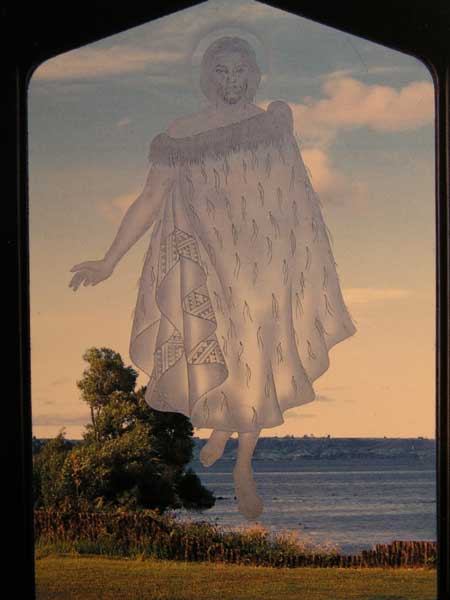
While returning from the church we came across this 'living fence'. The
fence is made from trees that are (or were) alive and were planted so close
together in a row that they form a solid wall.
In the evening we went to the Tamaki Maori Village (web site) for dinner. The village is a reproduction of a typical Maori village compound.
In years past, when one tribe wanted to visit another, the visiting tribe would approach the compound gate. The village chief would emerge from the gate and intimidate the chief of the visiting tribe by performing an aggressive battle display, brandishing his spear, etc. As he performed this display, he would watch the eyes of the visiting chief to detect signs of aggression in return. If he thought that the visiting chief was worthy and came in peace, all were welcomed and a peace token was placed on the ground which the visiting chief would pick up as an indication of his peaceful intentions. If the visiting chief did not appear to have come in peace a battle would ensue ...
If the peace token was offered, the visiting chief would proceed through the gate followed by the men of the tribe with the women and children following after them.
We (along with several other tour groups), the visiting 'tribes', came in several busses. On the way to the village each bus had to chose a chief. After several rounds where no one spoke up I volunteered and was unanimously elected chief of our Waka (Maori word for canoe or any mode of transportation, in this case our bus).
Here I'm being instructed in how to give the traditional Maori greeting which
I will have to give later in the evening. It consists of placing the left
hand on the shoulder of the other and gently touching noses twice.
I was carefully instructed to be sure to only touch noses twice - as to do it
three times was a marriage proposal!
There were five other chiefs in addition to myself. We stood in front of our 'villagers' to accept the challenge. We were admonished to remain still, no matter what ...
Apparently we stood up to the challenge well. War was not declared, the
lives of our villagers were spared, and the peace token was offered and
accepted.
We and our 'villagers' were welcomed in to their settlement where there were displays of crafts, dance, etc. ...
When it was time for our traditional dinner celebration we were invited (again, the chiefs first, followed by the men, followed by the women and children) to a traditional hangi (hang-gee), or dinner.
The food had been cooked underground on top of, and covered with, layers of hot rocks for 3 to 4 hours. This
was the age old cooking method used
by the Maori. The dinner consisted of chicken, lamb, baked fish, potatoes,
sweet potatoes, carrots, and dressing followed by the traditional New Zealand
pavlova, a meringue dessert served with fruit cocktail.
After dinner the bus drivers, who themselves were Maoris, sang a traditional Maori song and the chiefs were presented
with a special gift.
Our bus driver then instructed us chiefs in a traditional Maori farewell. He told us to raise our hand, palm towards our villagers, and move our hand alternately to the left and to the right ... you don't realize it when he's instructing you, but the result is funny ...
Riding home in the bus, our driver asked what countries we represented. He then asked the people from each country to sing a song which represented their country. Since we were in New Zealand touring steam railroads, we Americans sang "I've Been Working on The Railroad". The people from England sang, "Swing Low Sweet Chariot". One of the people on our tour, who is from Australia, used to belong to the Australian Navy and he favored us with a traditional Navy song. Our driver was a Maori and he sang one of their traditional songs in return.
The bus driver then asked everyone on the bus to join him in singing "The Wheels on the Bus (go round, round, round ...)". He then asked us all to start singing "She'll Be Coming 'Round the Mountain" - just then we entered one of the many 'round-abouts' that are so common here in New Zealand. He proceeded to drive around that same round-about 3 times as we sang "she'll be coming 'round the mountain when she comes, she'll be coming 'round the mountain when she comes ..."
Apparently the people in town are used to this as we discovered that this is a traditional part of the evening ... :-)
Next day: January 8th